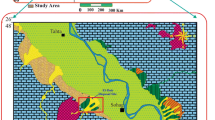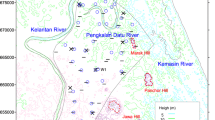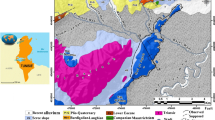Abstract
Underground water resources and soil are increasingly under threat due to refining activities near a residential area. Hydrocarbon contamination of groundwater and soil near the refinery in the Western part of the Niger Delta was carried out using the integrated techniques of electrical resistivity tomography (ERT), induced polarization, geotechnics, and geochemistry. Electrical imaging of the subsurface along the traverses in the site was taken through the use of an earth resistivity meter. Permeability of the soil was determined using a variable head permeameter and geochemical parameters of groundwater were deduced in an analytical laboratory. The resistivity imaging range is 10–2568 Ohm m, reflecting varying resistivity levels associated with lithology and liquid type. Low chargeability of 1–15 ms recorded in most parts implies that the sand has been infiltrated by a high-resistive plume. This low conductivity contaminant may be caused by hydrocarbon intrusion. The typical permeability of the soil is 6.00 × 10–5 m/s, indicating fairly good drainage conditions. Groundwater sample analysis shows slight acidity with a pH value of 5.3–6.6. Conductivity ranges from 74.50 to 119.60 µS/cm, while Total Dissolved Solids (TDS) is 51920 to 69,350 µg/L. Iron content is slightly high (645–977 g/L). Gas chromatography (GC) examination reveals that oil and grease as total petroleum hydrocarbons (TPH) is > 31 µg/L. The impermeable clay before the confined aquifer filters the TPH, which accounts for its low quantity in the water samples. The results have shown that the area has been degraded. It could be recommended that periodic integrated methods be carried out in the area.






Similar content being viewed by others
Data availability
The datasets and results presented in this work are available on request from the corresponding author.
References
ASTM. (2010). Standard test methods for measurement of hydraulic conductivity of saturated porous materials using a flexible wall permeameter.” D5084, Philadelphia
Ayolabi, E. A. (2005). Geoelectric evaluation of Olushosun landfill site Southwest Nigeria and its implication on groundwater. J. Geological Society of India, 66, 318–322.
Balia, R., Gavaudo, E., Ardau, F., & Ghiglieri, G. (2003). Geophysical approach to the environmental study of a coastal plain. Geophysics, 68(5), 1446–1459.
Baird, J. (2010). Oil Shame in Africa. Environmental Analyst, 2(6), 76–85.
Benard, J. (2003). Short note on the principles of geophysical methods for groundwater investigations. www.Terraplus.com info@terraplus.com. Accessed on 7 Aug 2022.
Doust, H., Omatsola, E. (1990). Niger Delta. In: Divergent and Passive Margin Basins (Eds. Edwards, J. D. and Santogrossi, P. A.).American Association of Petroleum Geologists, Tulsa, USA, 239–248.
Egbai, J. C. (2011). Resistivity method: A tool for identification of areas of corrosive groundwater in Agbor, Delta State, Nigeria. Journal of Emerging Trends in Engineering and Applied Sciences (JETEAS), 2, 226–230.
Ehirim, C. N., Adizua, O. F., & Okene, I. C. P. (2016). Geoelectrical characterization of matured petroleum hydrocarbon impacted soil in Port Harcourt, Nigeria. Asian Journal of Earth Sciences, 9, 9–15.
Merki, P. J. (1970). Structural geology of the Cenozoic Niger Delta. African Geology, Uni. of Ibadan Press pp. 251–268
Obasi, R. A., & Balogun, O. (2001). Water quality and environmental impact assessment of water resources in Nigeria. African Journal of Environmental Science and Technology, 2(2), 228–231.
Omo – Irabor, O. O., Oduyemi, K. (2006). A hybrid image classification approach for the systematic analysis of land cover (LC) changes in the Niger Delta Region: Proceedings of the 6th Int’l conference on earth observation and geoinformation sciences in support of Africa’s development. Cairo, Egypt.
Ostad-Ali-Askari, K. (2022). Management of risks substances and sustainable development. Applied Water Science, 12, 65. https://doi.org/10.1007/s13201-021-01562-7
Talebmorad, H., & Ostad-Ali-Askari, K. (2022). Hydro geo-sphere integrated hydrologic model in modeling of wide basins. Sustainable Water Resources Management, 8, 118. https://doi.org/10.1007/s40899-022-00689-y
Tamuno, S., & Felix, J. M. (2006). Crude oil resource: A blessing or curse to Nigeria—The case of The Niger Delta. Journal of Research in National Development, 4(2), 53–58. https://doi.org/10.4314/jorind.v4i2.42332
Tse, A. C., Nwankwo, A. C. (2013). An integrated geochemical and geoelectrical investigation of an ancient crude oil spill site in south east port-Harcourt, southern Nigeria. Ife Journal of Science., 15(1),
Uchegbulam, O., & Ayolabi, E. A. (2014). Application of electrical resistivity imaging in investigating groundwater pollution in Sapele Area, Nigeria. Journal of Water Resource and Protection, 6, 1369–1379. https://doi.org/10.4236/jwarp.2014.614126
Uko, E. D., Ekine, A. S., Ebeniro, J. O., & Ofoegbu, C. O. (1992). Weathering structure of the east-central Niger Delta, Nigeria. Geophysics, 57, 1228–1233. https://doi.org/10.1190/1.1443338
Urhobo Historical Society. (1986). http://www.waado.org/ nigerdelta/Maps/Oilfields.html (Accessed 18 Mar 2021).
West, T. R. (2010). Geology applied to engineering, 1st edn. Waveland Pr Inc.
Acknowledgements
The authors express gratitude to the Nigerian military operatives guarding the pipelines who permitted them to carry out the survey near the refinery. They equally thank the management of Western Delta University, Oghara, who contacted the Nigerian Army unit in the area to ask for permission to carry out the survey.
Author information
Authors and Affiliations
Corresponding author
Ethics declarations
Conflict of interest
There is no conflict of interest, as declared by the authors.
Rights and permissions
Springer Nature or its licensor (e.g. a society or other partner) holds exclusive rights to this article under a publishing agreement with the author(s) or other rightsholder(s); author self-archiving of the accepted manuscript version of this article is solely governed by the terms of such publishing agreement and applicable law.
About this article
Cite this article
Uchegbulam, O., Ugbe, F., Ameloko, A.A. et al. Integrating electrical resistivity, geotechnical and geochemical techniques to assess soil and groundwater resources near Warri refinery, Niger Delta, Nigeria. Int J Energ Water Res (2023). https://doi.org/10.1007/s42108-022-00230-z
Received:
Accepted:
Published:
DOI: https://doi.org/10.1007/s42108-022-00230-z




